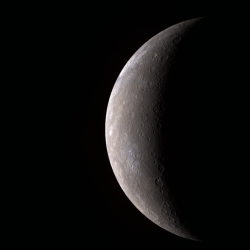The MESSENGER science team released more pictures from the Jan. 14 flyby, including what we've all been waiting for, the first one in color! But if you're looking for spectacular, eye-catching color, well, sorry, its just not part of Mercury's make-up.
The color image was created by combining three separate images taken through MESSENGER's Wide Angle Camera (WAC) filters in the infrared, far red, and violet wavelengths (red, green, and blue filters for this image.) MESSENGER's eyes can see far beyond the color range of the human eye, and the colors seen in this image are somewhat different from what a human would see.
Creating a false-color image in this way brings out color differences on Mercury's surface that cannot be seen in the black and white images released earlier.
The WAC has 11 narrow-band color filters, in contrast to the two visible-light filters and one ultraviolet filter that were on Mariner 10's camera. By combining images taken through different filters in the visible and infrared, the MESSENGER data allow Mercury to be seen in a variety of high-resolution color views not previously possible. This visible-infrared image shows an incoming view of Mercury, about 80 minutes before MESSENGER's closest pass of the planet from a distance of about 27,000 kilometers (17,000 miles).
I love this image of Mercury's south pole limb. It shows the terminator; the transition from the sunlit, day side of Mercury to the dark, night side of the planet. In the region near the terminator, the sun shines on the surface at a low angle, causing the rims of craters to cast long shadows, which brings out the height differences of the surface features. This image was acquired about 98 minutes after MESSENGER's closest approach to Mercury, when the spacecraft was at a distance of about 33,000 kilometers (21,000 miles).
And here's one for the scientist in you: the first data returned from MESSENGER's Mercury Atmospheric and Surface Composition Spectrometer (MASCS). What the image on the right shows with the bar-graph type lines is a high-resolution spectra of the planet's surface in ultraviolet, visible, and near-infrared light. The image on the left shows a portion of the ground-track along which the MASCS instrument took over 650 observations of the surface. The area is about 300 kilometers (190 miles) across. For those of you not fluent in spectra-ese, this shows the relative amount of sunlight reflected from the surface at wavelengths from the ultraviolet to the visible (rainbow) to the infrared.
Original News Source:
MESSENGER Press Releases
 Universe Today
Universe Today
